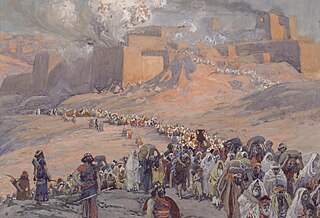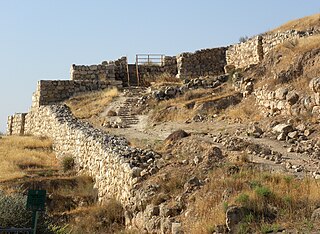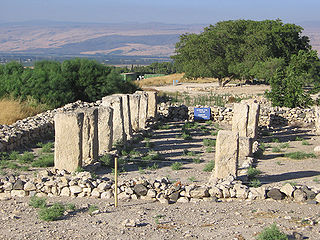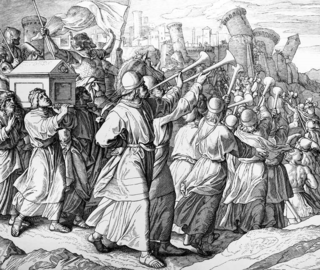Related Research Articles

The history of ancient Israel and Judah begins in the Southern Levant region of Western Asia during the Late Bronze Age and Early Iron Age. "Israel" as a people or tribal confederation appears for the first time in the Merneptah Stele, an inscription from ancient Egypt that dates to about 1208 BCE, with the people group possibly being older. According to modern archaeology, ancient Israelite culture developed as an outgrowth from the Semitic Canaanites. Two related Israelite polities known as the Kingdom of Israel (Samaria) and the Kingdom of Judah had emerged in the region by Iron Age II.

The Kingdom of Judah was a Semitic-speaking kingdom of the Southern Levant during the Iron Age. Centered in the highlands of Judea, the kingdom's capital was Jerusalem. Jews are named after Judah and are primarily descended from it.

The Kingdom of Israel, or the Kingdom of Samaria, was an Israelite kingdom in the Southern Levant during the Iron Age. The kingdom controlled the areas of Samaria, Galilee and parts of Transjordan. Its capital, for the most part, was Samaria.

The Philistines were an ancient people who lived on the south coast of Canaan during the Iron Age.

Samaria is a historic and biblical name used for the central region of Palestine, bordered by Judea to the south and Galilee to the north.

The Israelites were a group of Semitic-speaking tribes in the ancient Near East who, during the Iron Age, inhabited a part of Canaan.

The Babylonian captivity or Babylonian exile is the period in Jewish history during which a large number of Judeans from the ancient Kingdom of Judah were captives in Babylon, the capital city of the Neo-Babylonian Empire, following their defeat in the Jewish–Babylonian War and the destruction of Solomon's Temple in Jerusalem. The event is known to be historical, and is described in the Hebrew Bible in addition to archaeological and extra-biblical sources.

Lachish was an ancient Canaanite and Israelite city in the Shephelah region of Israel, on the south bank of the Lakhish River, mentioned several times in the Hebrew Bible. The current tell (ruin) by that name, known as Tel Lachish or Tell ed-Duweir, has been identified with the biblical Lachish. Today, it is an Israeli national park operated and maintained by the Israel Nature and Parks Authority. The park was established on lands of the depopulated Palestinian village of Qobebet Ibn ‘Awwad which was north of the Tel. It lies near the present-day moshav of Lakhish.
The historicity of the Bible is the question of the Bible's relationship to history—covering not just the Bible's acceptability as history but also the ability to understand the literary forms of biblical narrative. One can extend biblical historicity to the evaluation of whether or not the Christian New Testament is an accurate record of the historical Jesus and of the Apostolic Age. This tends to vary depending upon the opinion of the scholar.

Israel Finkelstein is an Israeli archaeologist, professor emeritus at Tel Aviv University and the head of the School of Archaeology and Maritime Cultures at the University of Haifa. Finkelstein is active in the archaeology of the Levant and is an applicant of archaeological data in reconstructing biblical history. He is also known for applying the exact and life sciences in archaeological and historical reconstruction. Finkelstein is the current excavator of Megiddo, a key site for the study of the Bronze and Iron Ages in the Levant.

Tel Hazor, also Chatsôr, translated in LXX as Hasōr, named in Arabic Tell Waqqas / Tell Qedah el-Gul, is an archaeological tell at the site of ancient Hazor, located in Israel, Upper Galilee, north of the Sea of Galilee, in the northern Korazim Plateau. Both as a Middle Bronze Age Canaanite city and as an Israelite one, Hazor was the largest fortified city in the country and one of the most important in the Fertile Crescent. It maintained commercial ties with Babylon and Syria, and imported large quantities of tin for the bronze industry. In the Book of Joshua, Hazor is described as "the head of all those kingdoms". Though some scholars do not consider the Book of Joshua to be historically accurate, archaeological excavations have emphasized its importance.

The United Monarchy is a political entity described in the deuteronomistic history of the Hebrew Bible as, under the reigns of Saul, David, and Solomon, encompassing the territories of both the later kingdoms of Judah and Israel. Whether the United Monarchy existed is a matter of ongoing academic debate, and scholars remain divided between those who support the historicity of the biblical narrative, those who doubt or dismiss it, and those who support the kingdom's theoretical existence while maintaining that the biblical narrative is exaggerated. Proponents of the kingdom's existence traditionally date it to between c. 1047 BCE and c. 930 BCE.

Tel Arad, in Arabic Tell 'Arad, is an archaeological tell, or mound, located west of the Dead Sea, about 10 kilometres west of the modern Israeli city of Arad in an area surrounded by mountain ridges which is known as the Arad Plain. The site is divided into a lower city and an upper section on a hill.
Bryant G. Wood is an American biblical archaeologist and young earth creationist. Wood is known for arguing that the destruction of Jericho could be accorded with the biblical literalist chronology of c. 1400 BC. This date is some 150 years later than the accepted date of c. 1550 BC, first determined by Kathleen Kenyon and subsequently confirmed with a variety of methods including radiocarbon dating.

The Battle of Jericho, as described in the Biblical Book of Joshua, was the first battle fought by the Israelites in the course of the conquest of Canaan. According to Joshua 6:1–27, the walls of Jericho fell after the Israelites marched around the city walls once a day for six days, seven times on the seventh day, and then blew their horns. Excavations at Tell es-Sultan, the biblical Jericho, have failed to substantiate this story, which has its origins in the nationalist propaganda of much later kings of Judah and their claims to the territory of the Kingdom of Israel. The lack of archaeological evidence and the composition, history and theological purposes of the Book of Joshua have led archaeologists like William G. Dever to characterise the story of the fall of Jericho as "invented out of whole cloth".

David Ussishkin is an Israeli archaeologist and professor emeritus of archaeology.
Biblical minimalism, also known as the Copenhagen School because two of its most prominent figures taught at Copenhagen University, is a movement or trend in biblical scholarship that began in the 1990s with two main claims:
- that the Bible cannot be considered reliable evidence for what had happened in ancient Israel; and
- that "Israel" itself is a problematic subject for historical study.
Niels Peter Lemche is a biblical scholar at the University of Copenhagen, whose interests include early Israel and its relationship with history, the Old Testament, and archaeology.

Avraham Biran was an Israeli archaeologist, best known for heading excavations at Tel Dan in northern Israel. He headed the Institute of Archaeology at Hebrew Union College in Jerusalem for many years.
Seymour Gitin is an American archaeologist specializing in ancient Israel, known for his excavations at Tel Miqne-Ekron. He was the director of the Albright Institute of Archaeological Research (AIAR) in Jerusalem from 1980 to 2014.
References
- ↑
- Blakely, Jeffrey A.; Horton, Fred L. (2001). "On Site Identifications Old and New: The Example of Tell el-Hesi". Near Eastern Archaeology . 64 (1/2): 32-33. doi:10.2307/3210818.
- ↑ "Proof of King David? Not yet. But riveting site shores up roots of Israelite era". Times of Israel. 14 May 2018. Retrieved 24 October 2019.